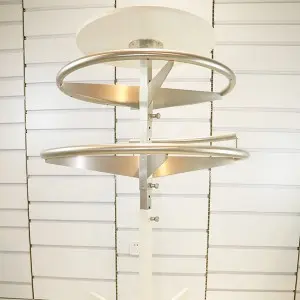Dec . 07, 2024 06:39 Back to list
display fitting
Display Fitting The Art of Perfect Presentation
In the realm of visual merchandising and retail design, display fitting has emerged as an essential concept that embodies the art of presenting products in a manner that captivates and engages potential customers. Display fitting goes beyond merely arranging items on shelves; it encompasses a strategic approach that combines aesthetics, functionality, and user experience to maximize the appeal and sales potential of merchandise. This article delves into the nuances of display fitting, examining its principles, techniques, benefits, and its significance in today’s retail landscape.
Understanding Display Fitting
At its core, display fitting refers to the methods and practices used to enhance product presentation through thoughtful design and layout. It involves utilizing various types of display fixtures, including shelving units, racks, mannequins, and showcases, to create an inviting shopping environment. The goal is to draw customer attention, evoke interest, and ultimately encourage purchase decisions.
Principles of Effective Display Fitting
Several key principles underpin effective display fitting
1. Visual Hierarchy This principle prioritizes the arrangement of items to guide the viewer’s eye naturally across the display. High-demand products or seasonal items are typically placed at eye level, while lesser-known items can be positioned on lower or higher shelves. The use of focal points, such as bold signage or featured displays, can further enhance visual hierarchy.
2. Color Coordination Colors play an integral role in display fitting, influencing mood and perception. A cohesive color scheme can create a harmonious look, while contrasting colors can highlight specific products. Seasonal palettes that resonate with current trends can also stimulate consumer interest and drive sales.
3. Target Audience Consideration Understanding the target demographic is crucial in display fitting. Displays should resonate with the preferences, lifestyles, and purchasing behaviors of the intended audience. For instance, a display aimed at young adults may favor a more modern, minimalistic look, while a display for families might emphasize comfort and accessibility.
4. Accessibility and Flow A well-fitted display allows for smooth navigation throughout the retail space. Customers should be able to move freely without feeling cramped or overwhelmed. Creating an intuitive flow encourages exploration and prolonged engagement with the products on display.
display fitting

5. Storytelling Effective display fitting often tells a story that connects emotionally with customers. A curated display that evokes a lifestyle or theme can inspire imagination and make products more relatable. For example, a summer beach-themed display may incorporate props such as sand and surfboards, transforming mere merchandise into a lifestyle experience.
Techniques in Display Fitting
Retailers employ a variety of techniques to implement effective display fitting. These include
- Zoning Dividing the store into distinct areas or zones, such as seasonal, promotional, or category-specific sections, helps guide customers through the shopping experience.
- Cross-Merchandising This technique involves displaying complementary products together, encouraging additional purchases. For instance, placing swimwear next to sunglasses and beach towels creates a cohesive experience that prompts buyers to consider all the essentials for a day at the beach.
- Lighting Strategic lighting can significantly enhance product visibility and allure. Highlighting key items through spotlights or soft, ambient lighting can create an inviting atmosphere that draws customers in.
The Benefits of Effective Display Fitting
The advantages of well-executed display fitting are manifold. Firstly, it boosts the overall aesthetic appeal of the store, creating an inviting atmosphere that can increase foot traffic. Secondly, effective displays can significantly improve sales performance by facilitating product discovery and enhancing consumer desire. Additionally, a strong display contributes to brand identity, reinforcing the store's image and values through visual presentation.
Conclusion
In conclusion, display fitting is not merely about arranging products; it is a sophisticated blend of art and science that plays a crucial role in the retail environment. By adhering to the principles of visual hierarchy, color coordination, audience consideration, accessibility, and storytelling, retailers can create compelling displays that resonate with customers and drive sales. As consumer behaviors evolve, the importance of display fitting will undoubtedly continue to grow, making it an indispensable element of retail success in an increasingly competitive marketplace.
-
The Impact of Display Racks on Promoting Sustainable Product Consumption
NewsMay.14,2025
-
The Display Table Is A Catalyst For Sustainable Consumer Engagement
NewsMay.14,2025
-
Sustainable Modern Retail Store Fixtures
NewsMay.14,2025
-
Store Design Innovations for Enhanced Customer Experience and Sales
NewsMay.14,2025
-
How Shoe Shop Displays Influence Sustainable Footwear Choices
NewsMay.14,2025
-
How Display Counter Aids in Efficient Resource Management in Communities
NewsMay.14,2025


















































































































